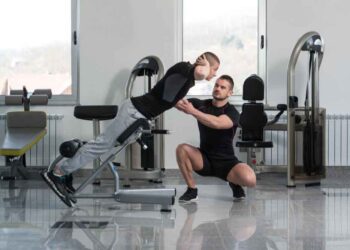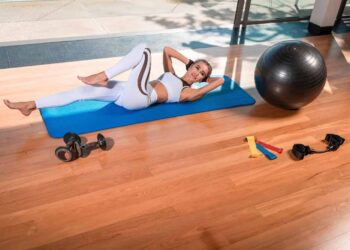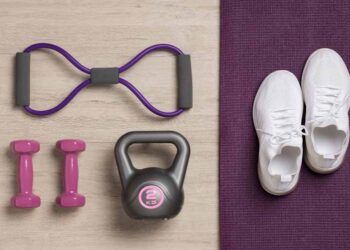Have you ever wondered how some people effortlessly hold a plank for minutes while others struggle to last a few seconds? What if I told you there are secrets to mastering this simple yet powerful exercise that can take your core strength to new heights?
Planking is not just about showcasing rock-solid abs, but it’s also an incredible way to strengthen your entire core. By engaging muscles like your abs, shoulders, chest, back, and thighs, planking can transform your fitness journey and unlock your full potential.
Are you ready to discover the secrets to maximizing your core strength through planking? Let’s dive in!
Key Takeaways:
- Planking is a powerful exercise that targets your core, including muscles like your abs, shoulders, chest, back, and thighs.
- Mastering the technique and progression of planking can enhance your core stability and help you achieve peak fitness.
- Proper breathing and muscle engagement are key factors in effective planking.
- By incorporating balance and stability challenges, you can take your planking routine to the next level.
- A strong core is essential for overall fitness and can positively impact your posture, metabolism, and injury prevention.
The Benefits of Planks (Front, Side) Exercise
Planks are one of the most effective exercises you can do for your body. Not only do they target your core muscles, such as the rectus abdominis, obliques, and transverse abdominis, but they also provide a wide range of benefits that can improve your overall fitness.
One of the primary benefits of planks is their ability to strengthen your core. By engaging these muscles consistently, you can develop a more defined midsection and improve your posture. Strong core muscles also contribute to better balance and stability, enhancing your performance in other exercises and daily activities.
Another advantage of planking is its ability to provide a total-body workout. As you hold the plank position, you activate muscles in your shoulders, chest, and back, which helps to improve upper body strength and stability. This comprehensive muscle engagement can lead to better overall functional fitness.
Planks also have the potential to boost your metabolism, making them a great addition to any weight loss or fitness program. The sustained muscle activation during planking increases your calorie burn, even after you finish your workout. This added metabolic boost can support weight loss and body composition goals.
Furthermore, planks are an excellent exercise for injury prevention. By strengthening your core muscles, planks can provide stability and support to your spine, reducing the risk of back pain and injuries. They can also help to improve your athletic performance by enhancing your body’s ability to absorb and transfer forces efficiently.
Lastly, planks offer mental benefits as well. Engaging in regular planking exercises can help build mental toughness and resilience, as you challenge yourself to hold the position for longer durations. Planks can also serve as a stress-reducing activity, providing a focused and meditative state that allows you to decompress from daily pressures.
In summary, planks offer a multitude of benefits, ranging from core strengthening and improved posture to total-body activation and injury prevention. Incorporating planks into your workout routine can help you achieve a stronger, more stable core, boost your metabolism, and enhance your overall physical and mental well-being.
The Power of Progression in Planking
To maximize the effectiveness of planking, it’s important to approach it with a strategic progression. Starting with shorter durations, such as 10-20 seconds, allows beginners to build a foundation and gradually increase their plank time. As you become more comfortable, you can add a few seconds or more to each session. Exploring different variations of planks, such as side planks and forearm planks, can also help challenge your body and keep your workouts engaging.
By gradually increasing the duration of your planks, you can push your limits and continually improve your core strength. This progression not only builds endurance but also allows your muscles to adapt and become stronger over time.
Remember, Rome wasn’t built in a day. Don’t rush the process, and trust that consistent progression will lead to impressive results.
Adding variety to your planking routine is crucial for preventing plateau and keeping your workouts fresh. Side planks work your obliques and challenge your stability, while forearm planks target your deep core muscles and enhance your overall strength.
Here are a few plank variations to incorporate into your routine:
- High Plank: Begin in a push-up position, supporting your weight on your palms and toes.
- Side Plank: Lie on your side and lift your body, resting on one forearm, with your legs extended and stacked on top of each other.
- Forearm Plank: Start by resting your weight on your forearms and toes, keeping your elbows directly beneath your shoulders.
As you progress in your planking journey, don’t be afraid to challenge yourself with more advanced variations, such as plank jacks or knee-to-elbow planks. These exercises not only engage your core but also target other muscle groups, providing a full-body workout.
Plank Progression Tips:
- Focus on maintaining proper plank form throughout each progression.
- Gradually increase plank duration by adding a few seconds or more to each session.
- Experiment with different plank variations to challenge your body and keep your workouts engaging.
- Listen to your body and adjust the intensity of your planks accordingly.
Remember, the key to success lies in consistent practice and gradual progression. By incorporating different plank variations and gradually increasing the duration of your planks, you’ll unlock the full potential of this powerful exercise and achieve remarkable core strength.
Breathing Techniques for Effective Planking
Proper breathing technique is vital for maximizing the benefits of planking and maintaining proper form throughout the exercise. By incorporating deep, controlled breathing into your planking routine, you can enhance core stability, ensure an adequate oxygen supply to your muscles, and reduce stress and anxiety.
When performing planks, it’s essential to start by inhaling deeply through your nose before initiating the plank position. This deep inhalation helps expand your diaphragm, filling your lungs with fresh oxygen. As you hold the plank, exhale slowly and steadily through your mouth, focusing on maintaining a consistent breathing rhythm.
“Proper breathing during planking not only facilitates better oxygen exchange but also helps stabilize your core muscles. It allows you to maintain your form and hold the plank position for longer, ultimately improving your core strength and stability.” – Dr. Emily Roberts, Fitness Expert
By following proper breathing techniques, you ensure a continuous flow of oxygen-rich blood to your working muscles, promoting their endurance and preventing muscle fatigue. Additionally, deep breathing calms the nervous system, reducing stress levels and enabling better focus during your planking sessions.
Remember to avoid breath-holding during planks, as it can restrict your oxygen intake and create unnecessary tension in your muscles. Instead, focus on maintaining a steady breathing pattern to optimize your planking performance.
For effective planking and enhanced core stability, mastering proper breathing techniques is just as important as maintaining the correct form. Incorporate focused breathing into your planking routine to unlock the full potential of this core-strengthening exercise!
Engaging the Right Muscles in Planking
To get the most out of your planking routine, it’s important to engage the right muscles.
The rectus abdominis, obliques, and transverse abdominis are the primary muscles targeted in planks. However, it’s also crucial to engage your glutes, quadriceps, and muscles in your shoulders and upper back.
Proper muscle engagement ensures that you are maximizing the effectiveness of the exercise and preventing imbalances.
| Muscles Engaged | Primary Benefits |
|---|---|
| Rectus Abdominis | Creates six-pack abs and helps with overall core stability. |
| Obliques | Improves rotational strength, contributes to a defined waistline, and enhances side-to-side stability. |
| Transverse Abdominis | Strengthens the deep core muscles responsible for spinal support and stability. |
| Glutes | Enhances hip stability and power, contributing to better balance and overall body control. |
| Quadriceps | Provides extended leg stability, improves overall lower-body strength, and supports proper form during planks. |
| Shoulders and Upper Back | Activates the muscles required for proper posture and upper body strength, ultimately improving overall stability and reducing the risk of injuries. |
Balancing and Stabilizing in Planking
Achieving balance and stability is essential when it comes to mastering planks and taking your core strength to the next level. By incorporating various techniques and tools, you can challenge your balance, engage stabilizing muscles, and enhance your overall stability.
1. Incorporate Stability Aids
One way to challenge your balance further is by using stability aids such as stability balls or balance boards. These tools introduce an element of instability, forcing your core muscles to work harder to maintain balance. They also engage additional stabilizing muscles, helping you build a strong and stable core. Incorporate these aids into your planking routine to add variety and intensify your workouts.
2. Experiment with Different Positions
Another effective way to enhance your balance and stability during planks is by experimenting with different forearm and hand positions. By placing your forearms closer together or wider apart, you can challenge your stability and engage different muscle groups. Additionally, elevating your feet on a sturdy surface, such as an exercise bench or step, can further intensify the exercise and target specific muscle areas.
3. Consistent Practice and Proper Form
Consistency is key when it comes to developing balance and stability in planking. Regular practice allows your body to adapt and improve over time. Focus on maintaining proper form throughout your planks, ensuring that your body remains aligned and engaged. This includes keeping your core tight, hips level, and shoulders stacked directly above your elbows or hands. By maintaining proper form, you can train your core to stabilize effectively during planks.
Incorporating these balancing and stabilizing techniques into your planking routine will help you build core stability and take your strength training to new heights. Remember to progress gradually, challenge yourself with different variations, and prioritize maintaining proper form. By doing so, you’ll be able to unlock the full potential of planks and achieve exceptional core strength and stability.
Conclusion
Planking is more than just an abs workout; it is a highly effective means of core strengthening and stability improvement. By incorporating proper technique, progression, breathing, muscle engagement, and balance, you can maximize the benefits of planking and achieve a rock-solid core.
Whether you are a beginner or a seasoned fitness enthusiast, planks offer a versatile and efficient way to boost your core strength and overall fitness. With various plank variations, such as side planks and forearm planks, you can continually challenge your body and prevent workout plateaus.
So, get ready to unleash the power of a strong core. Start incorporating planking into your fitness routine and witness the incredible transformation in your core stability, abdominal strength, and overall physical well-being. Take the first step today and plank like a pro!














